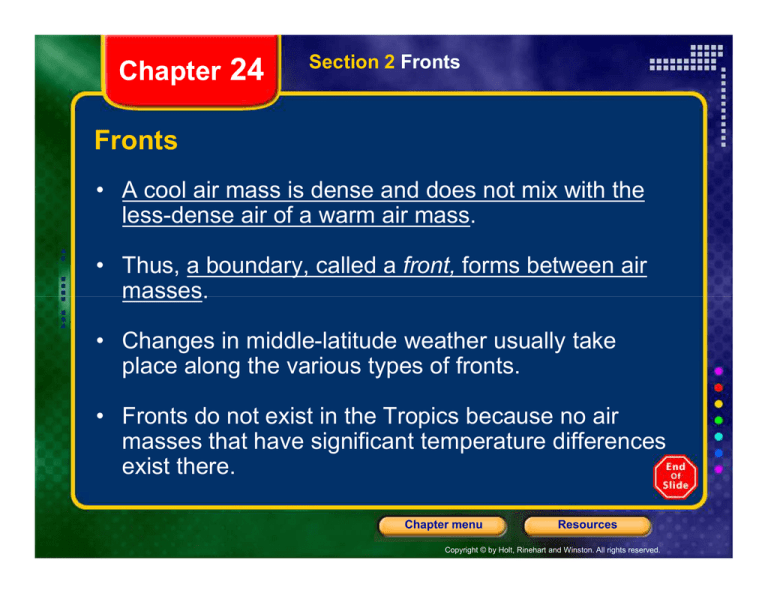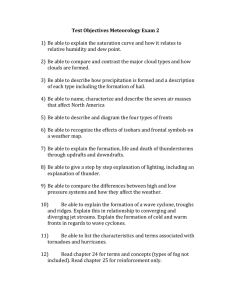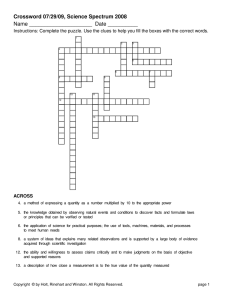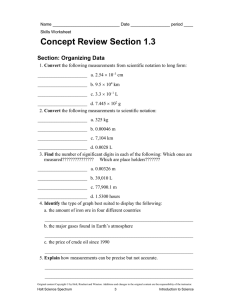
Chapter 24
Section 2 Fronts
Fronts
• A cool air mass is dense and does not mix with the
less-dense air of a warm air mass.
• Thus, a boundary, called a front, forms between air
masses.
• Changes in middle-latitude weather usually take
place along the various types of fronts.
• Fronts do not exist in the Tropics because no air
masses that have significant temperature differences
exist there.
Chapter menu
Resources
Copyright © by Holt, Rinehart and Winston. All rights reserved.
Chapter 24
Section 2 Fronts
Fronts, continued
Cold Fronts
cold front the front edge of a moving mass of cold air
that pushes beneath a warmer air mass like a wedge
• If the warm air is moist, clouds will form.
Chapter menu
Resources
Copyright © by Holt, Rinehart and Winston. All rights reserved.
Chapter 24
Section 2 Fronts
Fronts, continued
Cold Fronts, continued
• Large cumulus and cumulonimbus clouds typically
form along fast-moving cold fronts.
• A long line of heavy thunderstorms, called a squall
line, occurs in the warm, moist air ahead of a fastmoving cold front.
• A slow-moving cold front typically produces weaker
storms and lighter precipitation than a fast-moving
cold front does.
Chapter menu
Resources
Copyright © by Holt, Rinehart and Winston. All rights reserved.
Chapter 24
Section 2 Fronts
Fronts, continued
Warm Fronts
warm front the front edge of advancing warm air mass
that replaces colder air with warmer air
• The slope of a warm front is gradual.
• Because of this gentle slope, clouds may extend far
ahead of the surface location, or base, of the front.
• A warm front generally produces precipitation over a
large area and may cause violent weather.
Chapter menu
Resources
Copyright © by Holt, Rinehart and Winston. All rights reserved.
Chapter 24
Section 2 Fronts
Fronts, continued
Stationary and Occluded Fronts
stationary front a front of air masses that moves either
very slowly or not at all
occluded front a front that forms when a cold air mass
overtakes a warm air mass and lifts the warm air
mass off the ground and over another air mass
• Sometimes, when air masses meet, the cold moves
parallel to the front, and neither air mass is displaced.
Chapter menu
Resources
Copyright © by Holt, Rinehart and Winston. All rights reserved.
Chapter 24
Section 2 Fronts
Polar Fronts and Midlatitudes Cyclones
• Over each of Earth’s polar regions is a dome of cold
air that may extend as far as 60°latitude.
• The boundary where this cold polar air meets the
tropical air mass of the middle latitudes, especially
over the ocean, is called the polar front.
• Waves commonly develop along the polar front.
• A waves is a bend that forms in a cold front or
stationary front.
Chapter menu
Resources
Copyright © by Holt, Rinehart and Winston. All rights reserved.
Chapter 24
Section 2 Fronts
Polar Fronts and Midlatitudes Cyclones,
continued
midlatitude cyclone an area of low pressure that is
characterized by rotating wind that moves toward the
rising air of the central low-pressure region
• Waves are the beginnings of low-pressure storm
centers called midlatitude cyclones or wave cyclones.
• These cyclones strongly influence weather patterns
in the middle latitudes.
Chapter menu
Resources
Copyright © by Holt, Rinehart and Winston. All rights reserved.
Chapter 24
Section 2 Fronts
Polar Fronts and Midlatitudes Cyclones,
continued
Stages of a Midlatitude Cyclones
• A midlatitude cyclone usually last several days.
• In North America, midlatitude cyclones generally
travel about 45 km/h in an easterly direction as they
spin counterclockwise.
• They follow several storm tracks, or routes, as they
move from the Pacific coast to the Atlantic coast.
Chapter menu
Resources
Copyright © by Holt, Rinehart and Winston. All rights reserved.
Chapter 24
Section 2 Fronts
Polar Fronts and Midlatitudes Cyclones,
continued
The diagram below shows the different stages of a midlatitude cyclone.
Chapter menu
Resources
Copyright © by Holt, Rinehart and Winston. All rights reserved.
Chapter 24
Section 2 Fronts
Polar Fronts and Midlatitudes Cyclones,
continued
Anticyclones
• Unlike the air in the midlatitude cyclone, the air of an
anticyclone sinks and flows outward from a center of
high pressure.
• Because of the Coriolis effect, the circulation of air
around an anticyclone is clockwise in the Northern
Hemisphere.
• Anticyclones bring dry weather, because their
sinking air does not promote cloud formation.
Chapter menu
Resources
Copyright © by Holt, Rinehart and Winston. All rights reserved.
Chapter 24
Section 2 Fronts
Severe Weather
Thunderstorms
thunderstorm a usually brief, heavy storm that consists
of rain, strong winds, lightning, and thunder
• Thunderstorms develop in three distinct stages.
• The thunderstorm dissipates as the supply of water
vapor decrease.
Chapter menu
Resources
Copyright © by Holt, Rinehart and Winston. All rights reserved.
Chapter 24
Section 2 Fronts
Severe Weather, continued
Lightning
• During a thunderstorm, clouds discharge electricity in
the form of lightning.
• The released electricity heats the air, and the air
rapidly expands and produces a loud noise known as
thunder.
• For lightning to occur, the clouds must have areas
that carry distinct electrical charges.
Chapter menu
Resources
Copyright © by Holt, Rinehart and Winston. All rights reserved.
Chapter 24
Section 2 Fronts
Severe Weather, continued
Hurricanes
hurricane a severe storm that develops over tropical
oceans and whose strong winds of more than 120
km/h spiral in toward the intensely low-pressure
storm center
• A hurricane begins when warm, moist air over the
ocean rises rapidly.
• When moisture in the rising warm air condenses, a
large amount of energy in the from of latent heat is
released. This heat increase the force of the rising
air.
Chapter menu
Resources
Copyright © by Holt, Rinehart and Winston. All rights reserved.
Chapter 24
Section 2 Fronts
Severe Weather, continued
Hurricanes, continued
• A fully developed hurricane consists of a series of
thick cumulonimbus cloud bands that spiral upward
around the center of the storm.
• The most dangerous aspect of a hurricane is a rising
sea level and large waves, called a storm surge.
• Every hurricane is categorized on the Safir-Simpson
scale by using several factors. These factors include
central pressure, wind speed, and storm surge.
Chapter menu
Resources
Copyright © by Holt, Rinehart and Winston. All rights reserved.
Chapter 24
Section 2 Fronts
Severe Weather, continued
Tornadoes
tornado a destructive, rotating column of air that has
very high wind speeds and that maybe visible as a
funnel-shaped cloud
• The smallest, most violent, and shortest-lived severe
storm is a tornado.
• A tornado forms when a thunderstorm meets highaltitude horizontal winds. These winds cause the
rising air in the thunderstorm to rotate.
Chapter menu
Resources
Copyright © by Holt, Rinehart and Winston. All rights reserved.
Chapter 24
Section 2 Fronts
Severe Weather, continued
Tornadoes, continued
• A storm cloud may develop a narrow, funnel-shaped
rapidly spinning extension that reaches downward
and may or may not touch the ground.
• If the funnel does touch the ground, it generally
moves in a wandering, haphazard path.
• The destructive power of a tornado is due to mainly
the speed of the winds. These winds may reach
speeds of more than 400 km/h.
Chapter menu
Resources
Copyright © by Holt, Rinehart and Winston. All rights reserved.





